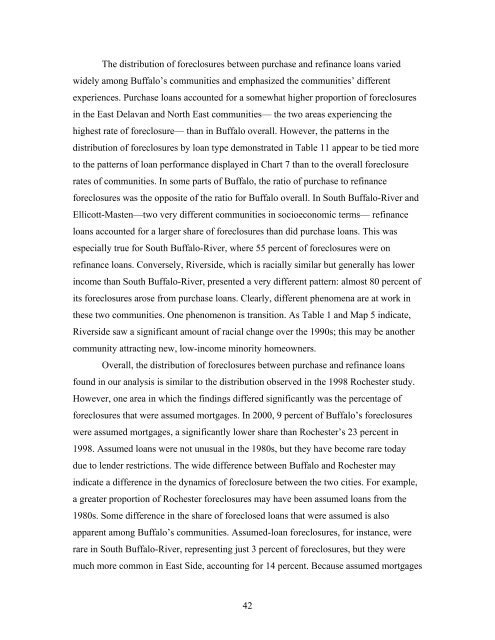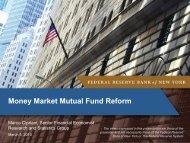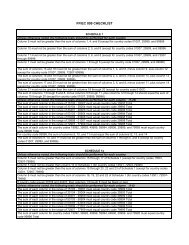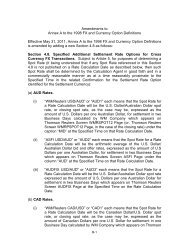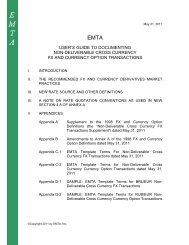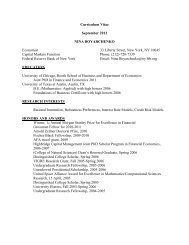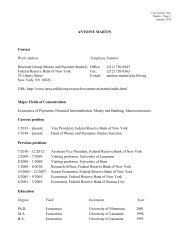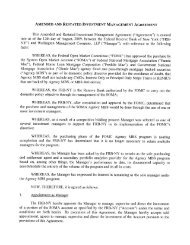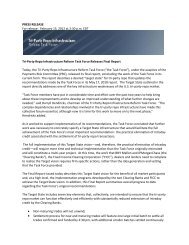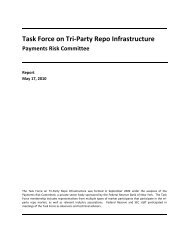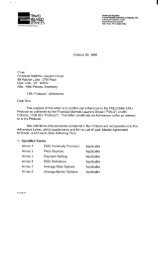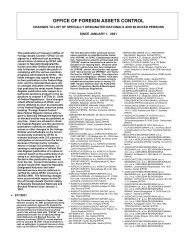Residential Foreclosures in the City of Buffalo, 1990-2000 - Federal ...
Residential Foreclosures in the City of Buffalo, 1990-2000 - Federal ...
Residential Foreclosures in the City of Buffalo, 1990-2000 - Federal ...
Create successful ePaper yourself
Turn your PDF publications into a flip-book with our unique Google optimized e-Paper software.
The distribution <strong>of</strong> foreclosures between purchase and ref<strong>in</strong>ance loans varied<br />
widely among <strong>Buffalo</strong>’s communities and emphasized <strong>the</strong> communities’ different<br />
experiences. Purchase loans accounted for a somewhat higher proportion <strong>of</strong> foreclosures<br />
<strong>in</strong> <strong>the</strong> East Delavan and North East communities— <strong>the</strong> two areas experienc<strong>in</strong>g <strong>the</strong><br />
highest rate <strong>of</strong> foreclosure— than <strong>in</strong> <strong>Buffalo</strong> overall. However, <strong>the</strong> patterns <strong>in</strong> <strong>the</strong><br />
distribution <strong>of</strong> foreclosures by loan type demonstrated <strong>in</strong> Table 11 appear to be tied more<br />
to <strong>the</strong> patterns <strong>of</strong> loan performance displayed <strong>in</strong> Chart 7 than to <strong>the</strong> overall foreclosure<br />
rates <strong>of</strong> communities. In some parts <strong>of</strong> <strong>Buffalo</strong>, <strong>the</strong> ratio <strong>of</strong> purchase to ref<strong>in</strong>ance<br />
foreclosures was <strong>the</strong> opposite <strong>of</strong> <strong>the</strong> ratio for <strong>Buffalo</strong> overall. In South <strong>Buffalo</strong>-River and<br />
Ellicott-Masten—two very different communities <strong>in</strong> socioeconomic terms— ref<strong>in</strong>ance<br />
loans accounted for a larger share <strong>of</strong> foreclosures than did purchase loans. This was<br />
especially true for South <strong>Buffalo</strong>-River, where 55 percent <strong>of</strong> foreclosures were on<br />
ref<strong>in</strong>ance loans. Conversely, Riverside, which is racially similar but generally has lower<br />
<strong>in</strong>come than South <strong>Buffalo</strong>-River, presented a very different pattern: almost 80 percent <strong>of</strong><br />
its foreclosures arose from purchase loans. Clearly, different phenomena are at work <strong>in</strong><br />
<strong>the</strong>se two communities. One phenomenon is transition. As Table 1 and Map 5 <strong>in</strong>dicate,<br />
Riverside saw a significant amount <strong>of</strong> racial change over <strong>the</strong> <strong>1990</strong>s; this may be ano<strong>the</strong>r<br />
community attract<strong>in</strong>g new, low-<strong>in</strong>come m<strong>in</strong>ority homeowners.<br />
Overall, <strong>the</strong> distribution <strong>of</strong> foreclosures between purchase and ref<strong>in</strong>ance loans<br />
found <strong>in</strong> our analysis is similar to <strong>the</strong> distribution observed <strong>in</strong> <strong>the</strong> 1998 Rochester study.<br />
However, one area <strong>in</strong> which <strong>the</strong> f<strong>in</strong>d<strong>in</strong>gs differed significantly was <strong>the</strong> percentage <strong>of</strong><br />
foreclosures that were assumed mortgages. In <strong>2000</strong>, 9 percent <strong>of</strong> <strong>Buffalo</strong>’s foreclosures<br />
were assumed mortgages, a significantly lower share than Rochester’s 23 percent <strong>in</strong><br />
1998. Assumed loans were not unusual <strong>in</strong> <strong>the</strong> 1980s, but <strong>the</strong>y have become rare today<br />
due to lender restrictions. The wide difference between <strong>Buffalo</strong> and Rochester may<br />
<strong>in</strong>dicate a difference <strong>in</strong> <strong>the</strong> dynamics <strong>of</strong> foreclosure between <strong>the</strong> two cities. For example,<br />
a greater proportion <strong>of</strong> Rochester foreclosures may have been assumed loans from <strong>the</strong><br />
1980s. Some difference <strong>in</strong> <strong>the</strong> share <strong>of</strong> foreclosed loans that were assumed is also<br />
apparent among <strong>Buffalo</strong>’s communities. Assumed-loan foreclosures, for <strong>in</strong>stance, were<br />
rare <strong>in</strong> South <strong>Buffalo</strong>-River, represent<strong>in</strong>g just 3 percent <strong>of</strong> foreclosures, but <strong>the</strong>y were<br />
much more common <strong>in</strong> East Side, account<strong>in</strong>g for 14 percent. Because assumed mortgages<br />
42


